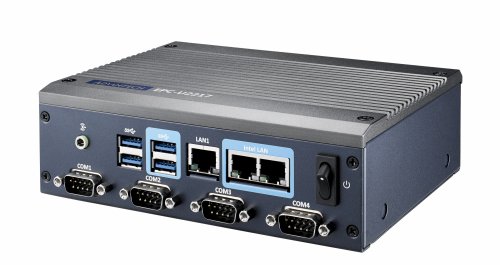By Nick Flaherty
www.flaherty.co.ukNordic Semiconductor has developed a flexible dual-processor hardware architecture and advanced security features for complex IoT applications using two ARM Cortex-M33 cores.
The nRF5340 combines a high performance application processor with a fully programmable, ultra low power network processor, plus advanced root-of-trust and trusted execution security features, into a low power multiprotocol SoC ready for professional lighting, industrial automation, advanced wearables, and other complex IoT applications
This is the first in the nRF53 family, building on the nRF51 and nRF52 Series multiprotocol SoCs. The nRF5340 supports major RF protocols including Bluetooth 5.1/Bluetooth Low Energy (Bluetooth LE), Bluetooth mesh, Thread, and Zigbee.
The nRF5340 SoC is designed for extended operating temperature up to 105°C, which together with its multiprotocol support and advanced security features makes it suited for professional lighting and industrial applications as well as wearables.
The QSPI peripheral is augmented to interface with external memory at 96 MHz, and a 32 MHz High Speed SPI peripheral is integrated to interface with displays and complex sensors.
The chip incorporates Arm CryptoCell-312, Arm TrustZone technology, and Secure Key Storage for the highest level of security. With Arm CryptoCell-312 the most common Internet encryption standards are hardware accelerated and Arm TrustZone provides system-wide hardware isolation for trusted software by creating secure and non-secure code execution areas on a single core. The nRF5340’s combined security features enable advanced root-of-trust and secure firmware updates while protecting the SoC from malicious attack.
The nRF5340 is based around dual Arm Cortex-M33 processors; a high performance application processor running up to 128 MHz (510 CoreMark) with dedicated 1 MB Flash and 512 KB RAM, and a fully programmable, ultra low power network processor running at 64 MHz (238 CoreMark) with dedicated 256 KB Flash and 64 KB RAM.
The application processor is optimised for power efficiency at 65 CoreMark/mA, has an 8 KB 2-way associative cache, is DSP and floating point capable and offers voltage and frequency scaling options. The application processor integrates the Arm Cryptocell-312, Arm TrustZone, and Secure Key Storage advanced security features, plus a wide range of interface peripherals including NFC, USB, QSPI, and High Speed SPI.
The M33 network processor is even more efficient at 101 CoreMark/mA and is optimised for low power during radio operation and low duty-cycle sensor data collection. Programmable access to the network processor offers optimal implementation of proprietary 2.4 GHz protocols, ensuring portability from the nRF51 and nRF52 Series.
The nRF5340 incorporates a new, power-optimized multiprotocol 2.4 GHz radio with a TX current of 3.2 mA (0 dBm TX power, 3 V, DC/DC) and RX current of 2.6 mA (3 V, DC/DC). Sleep current is as low as 1.1 µA. The SoC features enhanced dynamic multiprotocol support enabling concurrent Bluetooth LE and Bluetooth mesh/Thread/Zigbee operation for provisioning/commissioning and interaction with a mesh network from a smartphone using Bluetooth LE. The radio is capable of all Bluetooth 5.1 Direction Finding features. The nRF5340 operates over a 1.7 to 5.5 V supply voltage range, allowing supply from rechargeable batteries and USB. The SoC integrates XTAL load capacitors for both 32 MHz and 32.762 kHz crystals, lowering by four the number of external components required compared with Nordic’s nRF52 Series - reducing both bill-of-materials (BOM) and solution size.
The software development kit integrates the Zephyr RTOS, a Bluetooth LE protocol stack, application examples, and hardware drivers. It unifies low power cellular IoT and low power, short range wireless development and is publicly hosted on GitHub, offers source code management with Git and comes with free SEGGER Embedded Studio IDE support.
Nordic has also launched the nRF5340 PDK, an affordable, single board preview development kit for the nRF5340. The nRF5340 PDK makes all of the nRF5340’s features and GPIOs available to the developer and comes with an on-board SEGGER J-Link debugger for programming and debugging the SoC.
“Bluetooth, Thread, Zigbee and other low power wireless technologies now form a critical part of the IoT. Developers are already working on tomorrow’s commercial products based on highly-complex applications such as property tech, location services, medical, smart home, and Industrial IoT. These demand greater computational power with high security, yet developers expect Nordic’s wireless solutions to remain compact and highly energy-efficient,” says Kjetil Holstad, Director of Product Management at Nordic Semiconductor.
“The nRF5340 SoC is designed to meet these needs and more. The product is the culmination of Nordic’s decades of experience in ultra low power wireless, the lessons learned from the development and support of the nRF51 and nRF52 Series over the last seven years, and several years of focused product development from perhaps the most experienced low power wireless R&D team in the world. The nRF5340 and nRF Connect SDK combine to make it easy for developers to build wireless applications that until now were impossible.”
The nRF5340 PDK is available now through Nordic’s distribution network. nRF5340 SoC engineering samples will be available soon in a 7x7 mm aQFN package with 48 GPIOs.



 .
.  .
.  .
.  .
.  .
.  .
.  .
.  .
.  .
.  .
.  .
. 

